Burnt food stuck to your pan can be a real kitchen nightmare, but don’t worry, FOODS.EDU.VN is here to help you restore your cookware to its former glory! Discover expert-approved cleaning methods to effortlessly remove stubborn, burnt-on food residue. Dive in to learn how to clean scorched cookware, revive charred pans, and maintain your kitchen essentials with ease.
The primary audience for this content is home cooks, food enthusiasts, and anyone who’s ever faced the frustration of a burnt pan. These easy-to-follow solutions aim to help families enjoy meal times with delicious food made in perfectly clean cookware. Now, let’s discover how to remove those nasty burnt food stains!
1. Understanding the Culprit: Why Food Burns and Sticks
Before diving into cleaning methods, understanding why food burns and sticks to pans is crucial. Several factors contribute to this common kitchen woe:
- Insufficient Lubrication: A lack of oil, butter, or other cooking fats creates direct contact between the food and the hot pan surface, leading to burning and sticking.
- High Heat: Excessive heat causes food to cook too quickly, leading to scorching, especially if not monitored closely.
- Uneven Heat Distribution: Pans with poor heat distribution have hot spots, increasing the likelihood of food burning in those areas.
- Type of Food: Certain foods, like those high in sugar or starch, are more prone to burning and sticking.
- Pan Material: Some materials, such as stainless steel, require more attention to temperature control and lubrication than non-stick surfaces.
Understanding these factors helps prevent food from burning and sticking in the first place. Using adequate amounts of oil, maintaining moderate heat, and choosing quality cookware are essential steps.
2. Essential Tools and Supplies for Tackling Burnt Pans
Before embarking on your pan-cleaning mission, gather the necessary tools and supplies. Having these items on hand will make the process smoother and more efficient.
| Tool/Supply | Description |
|---|---|
| Baking Soda | A mild alkali that helps loosen burnt food particles. |
| White Vinegar | An acid that aids in breaking down stubborn residue. |
| Lemon | A natural cleaning agent with acidic properties. |
| Bar Keepers Friend | A powdered cleanser containing oxalic acid, effective for removing tough stains. |
| Aluminum Foil | Abrasive enough to scrub away burnt food without damaging the pan (use carefully). |
| Dish Soap | Helps to remove grease and remaining residue. |
| Sponges | Non-abrasive sponges for gentle scrubbing. |
| Scouring Pads | Abrasive pads for tougher stains (use with caution on delicate surfaces). |
| Rubber Gloves | Protects hands from harsh chemicals and hot water. |
| Wooden Spoon or Spatula | Useful for scraping off loosened food particles. |
| Water | Essential for soaking and rinsing. |
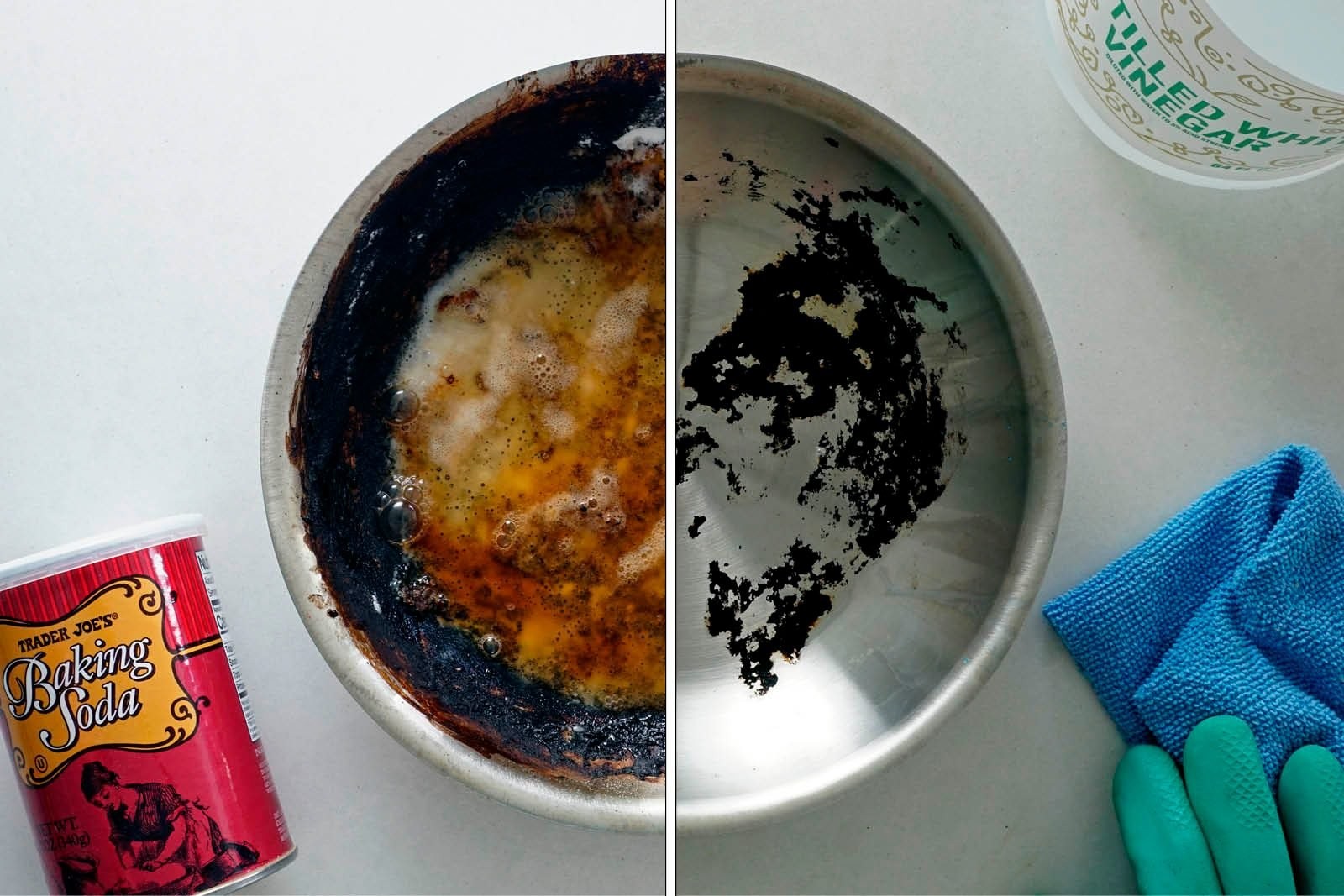
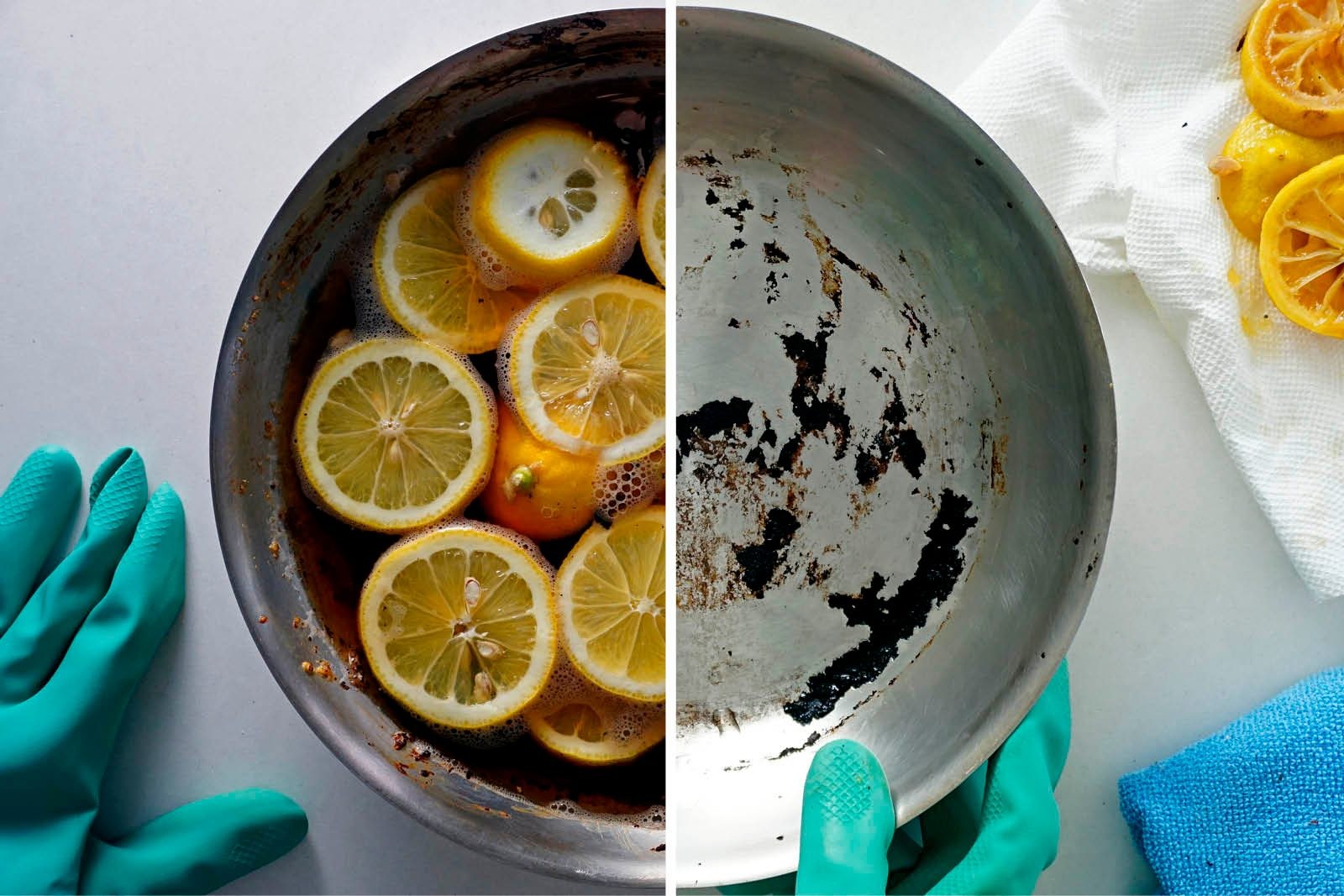
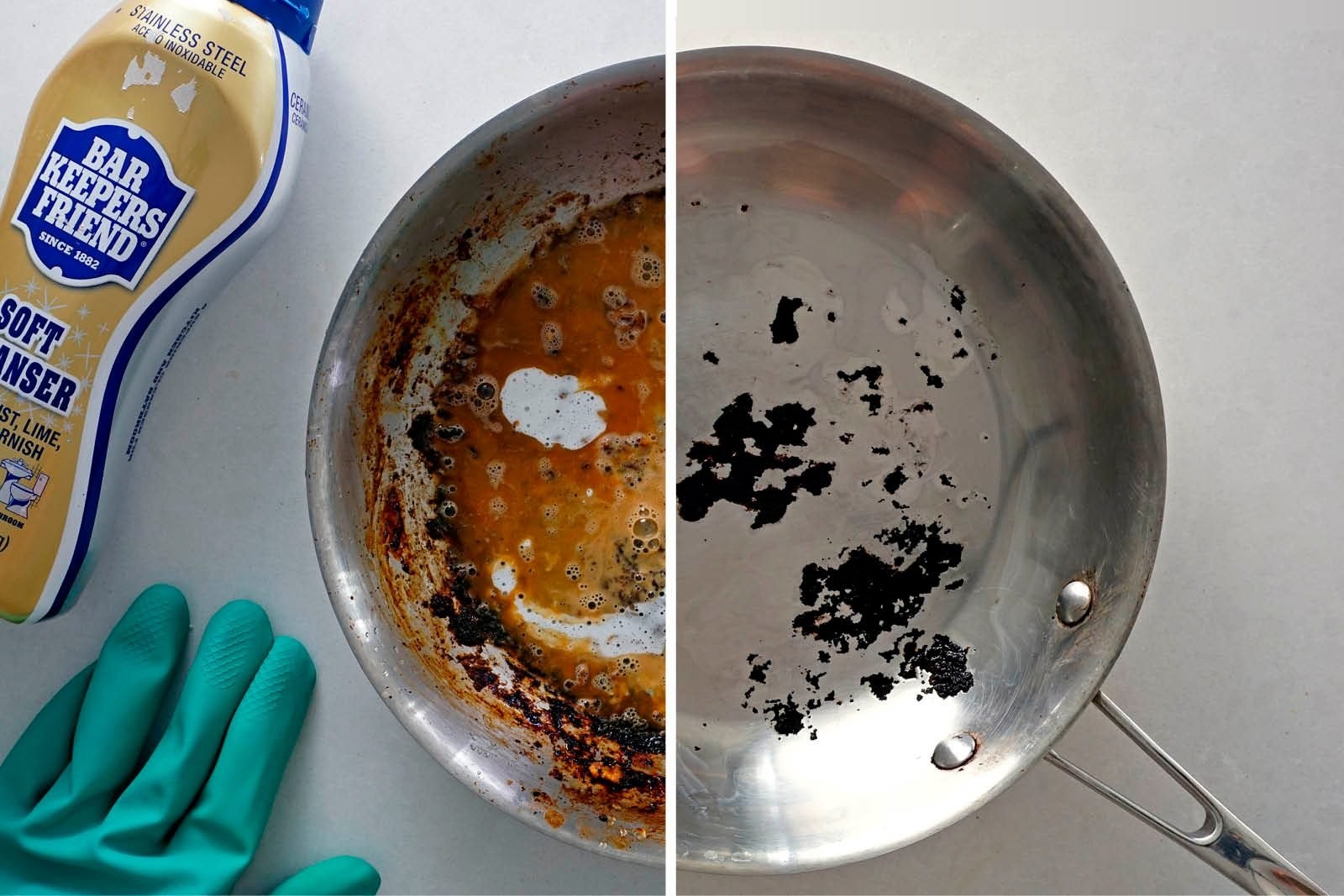
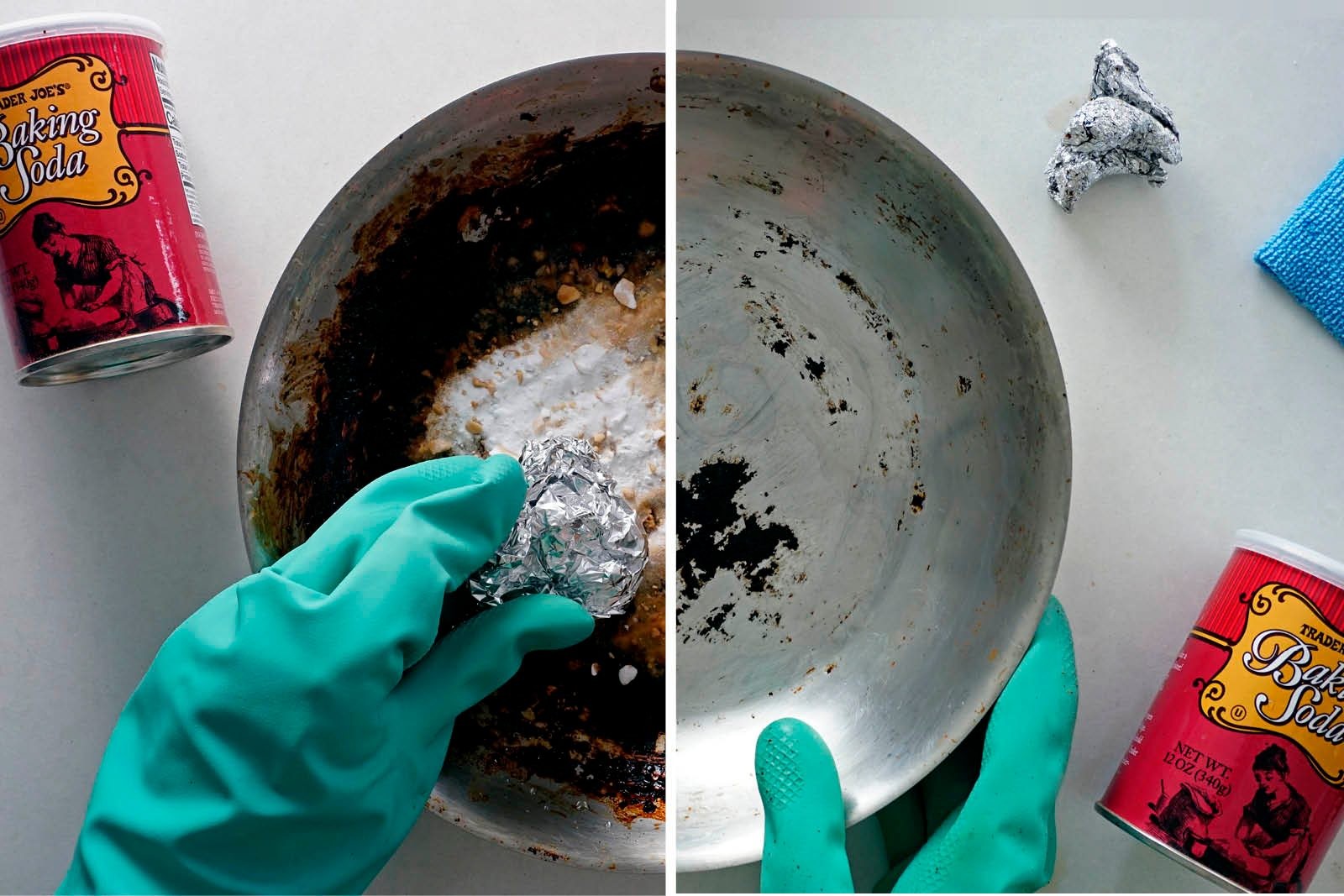
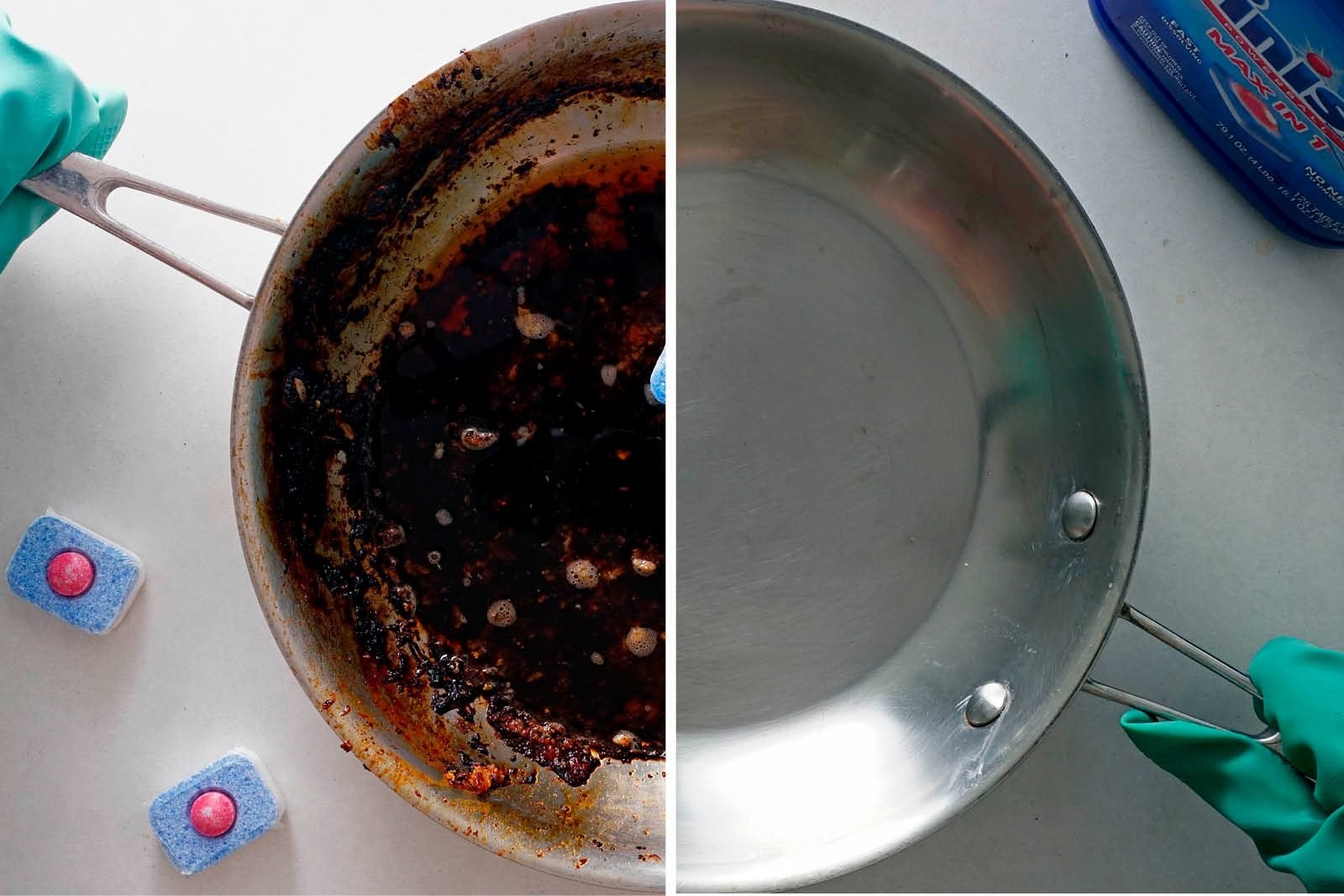
3. The Baking Soda and Vinegar Method: A Dynamic Duo
The baking soda and vinegar method is a classic, affordable, and effective way to remove burnt food from pans. It utilizes readily available pantry staples and is safe for most cookware.
How It Works:
- Fill the Pan: Pour equal parts water and white vinegar into the burnt pan, ensuring the burnt area is submerged.
- Boil the Mixture: Bring the mixture to a boil on the stovetop. This helps loosen the burnt-on food particles.
- Add Baking Soda: Remove the pan from heat and add two tablespoons of baking soda. The mixture will fizz, further aiding in the loosening process.
- Soak: Let the pan soak for 15-30 minutes, allowing the baking soda and vinegar to penetrate the burnt residue.
- Scrub: After soaking, pour out the liquid and use a non-abrasive sponge or scouring pad to scrub away the remaining burnt bits.
- Baking Soda Paste (Optional): For stubborn spots, create a paste of baking soda and water, apply it to the affected areas, and let it sit for a few minutes before scrubbing again.
alt: Pan being cleaned with a mixture of baking soda and vinegar
Benefits:
- Affordable and accessible ingredients
- Safe for most cookware materials
- Effective for loosening burnt food particles
Drawbacks:
- May require some elbow grease for heavily burnt pans
- The fizzing reaction can be messy if not done carefully
According to a study published in the “Journal of Chemical Education,” the combination of baking soda (a base) and vinegar (an acid) creates a chemical reaction that produces carbon dioxide gas, which helps to lift the burnt food particles from the pan’s surface.
4. The Lemon Boil: A Fresh and Natural Approach
For a natural and aromatic cleaning solution, the lemon boil method is an excellent choice. Lemons contain citric acid, a natural cleaning agent that helps to break down burnt residue.
How It Works:
- Slice the Lemons: Cut two to three lemons into slices.
- Arrange in Pan: Place the lemon slices in the burnt pan.
- Add Water: Fill the pan with enough water to cover the lemons and the burnt areas.
- Boil: Bring the lemon water to a boil and let it simmer for 5-10 minutes. You’ll notice food particles floating to the surface.
- Cool and Scrub: Remove the pan from the heat and let it cool slightly. Discard the lemons and drain the water.
- Scrub Away: Rinse the pan with hot water and use a sponge or scouring pad to scrub away the loosened burnt-on bits.
alt: A pan filled with lemon slices and water, used for cleaning burnt food.
Benefits:
- Natural and non-toxic
- Leaves a fresh, citrus scent
- Gentle on cookware
Drawbacks:
- May not be as effective for heavily burnt pans
- Requires a significant amount of lemons for large pans
According to the EPA, lemons are a safe alternative to chemical cleaners for some household cleaning tasks. However, as stated in the original article, lemons may not be as effective for tough messes.
5. Unleashing the Power of Bar Keepers Friend
Bar Keepers Friend is a powerful powdered cleanser containing oxalic acid, which is highly effective for removing tough stains and burnt-on food. However, it should be used with caution, as it can be abrasive.
How It Works:
- Wet the Pan: Rinse the burnt pan with hot water and drain.
- Create a Paste: Wearing rubber gloves, make a paste by mixing a few tablespoons of Bar Keepers Friend with a small amount of water.
- Apply and Wait: Spread the paste over the burnt debris and let it sit for 1-2 minutes. Do not let it sit for too long, as it can damage the pan surface.
- Scrub: Rinse the pan thoroughly with hot water and use a sponge, brush, or scouring pad to scrub away the loosened burnt-on food.
- Repeat if Necessary: For stubborn spots, repeat the process with a fresh application of the paste.
alt: Using Bar Keepers Friend to clean a burnt pan.
Benefits:
- Highly effective for removing tough stains and burnt-on food
- Works quickly
- Can be used on various surfaces in the home
Drawbacks:
- Can be abrasive, potentially damaging delicate cookware
- Requires wearing gloves to protect hands
- Oxalic acid can be irritating; use in a well-ventilated area
According to the product’s safety data sheet, Bar Keepers Friend contains oxalic acid, which can be harmful if swallowed or comes into contact with skin or eyes. Always use gloves and ensure adequate ventilation when using this product.
6. Aluminum Foil and Baking Soda: The Scrubbing Duo
Aluminum foil, combined with baking soda, provides an abrasive scrubbing action that can effectively remove burnt food particles. This method is particularly useful for stainless steel pans.
How It Works:
- Rinse and Sprinkle: Rinse the burnt pan with hot water and drain. Sprinkle generously with two tablespoons of baking soda.
- Create a Paste: Add a few teaspoons of hot water to the pan to form a paste with the baking soda.
- Scrub with Foil: Crumple a piece of aluminum foil into a ball and use it to scrub the burnt areas. The foil acts as an abrasive, helping to lift the grime.
- Rinse and Wash: Continue scrubbing until all the burnt debris is removed. Rinse the pan with hot, soapy water to finish cleaning.
alt: Cleaning a burnt pan using aluminum foil and baking soda.
Benefits:
- Effective scrubbing action
- Uses readily available materials
- Good for stainless steel pans
Drawbacks:
- Can scratch delicate surfaces if used too aggressively
- Requires some elbow grease
Aluminum foil is a common household item and can be an effective scrubbing tool. However, be cautious when using it on non-stick surfaces to avoid scratching.
7. The Dishwasher Tablet Trick: An Unexpected Solution
Dishwasher tablets are not just for dishwashers; they can also be used to clean burnt pans. This method is surprisingly effective, thanks to the powerful cleaning agents in the tablets.
How It Works:
- Rinse the Pan: Rinse the burnt pan with hot water.
- Scrub with Tablet: Gently scrub the pan under warm water with a dishwasher tablet.
- Dissolve and Scrub: The warm water will gradually dissolve the tablet as you scrub, releasing the cleaning agents.
- Rinse and Repeat: Continue scrubbing until all the food debris is lifted. Rinse the pan thoroughly with warm water. You may need to use more than one tablet for heavily burnt pans.
alt: Cleaning a burnt skillet with a dishwasher tablet.
Benefits:
- Very effective at removing burnt-on food
- Requires minimal effort
- Uses a product already found in many homes
Drawbacks:
- Can be expensive if multiple tablets are needed
- Some tablets may leave a residue, requiring thorough rinsing
Dishwasher tablets contain enzymes and detergents that break down food particles, making them effective for cleaning burnt pans. However, always rinse thoroughly to remove any residue.
8. Preventing Future Burns: Tips and Best Practices
Prevention is always better than cure. By following these tips and best practices, you can minimize the chances of burning food and making your pans difficult to clean:
- Use Adequate Lubrication: Always use enough oil, butter, or cooking spray to coat the pan surface evenly.
- Control the Heat: Cook at moderate temperatures to prevent food from burning quickly.
- Stir Frequently: Stir food regularly to ensure even cooking and prevent sticking.
- Use the Right Cookware: Choose high-quality pans with good heat distribution.
- Don’t Overcrowd the Pan: Overcrowding can lower the pan’s temperature, leading to uneven cooking and burning.
- Soak Immediately: If food does burn, soak the pan in hot, soapy water as soon as possible to prevent the residue from hardening.
- Regular Cleaning: Clean your pans thoroughly after each use to prevent buildup and make future cleaning easier.
9. Choosing the Right Cookware: Material Matters
The material of your cookware significantly impacts how easily food burns and sticks. Here’s a quick guide to choosing the right cookware:
| Cookware Material | Pros | Cons | Best Uses |
|---|---|---|---|
| Non-Stick | Easy to clean, requires less oil | Can scratch easily, not suitable for high heat | Eggs, pancakes, delicate foods |
| Stainless Steel | Durable, versatile, oven-safe | Food can stick easily, requires more oil | Searing, browning, boiling |
| Cast Iron | Excellent heat retention, naturally non-stick when seasoned | Heavy, requires seasoning, can rust | Searing, frying, baking |
| Ceramic | Non-toxic, easy to clean | Can lose non-stick properties over time, not as durable as other materials | Sautéing, baking |
| Copper | Excellent heat conductivity, aesthetically pleasing | Expensive, requires polishing, can react with acidic foods | Precise cooking, sauces |
By understanding the strengths and weaknesses of each material, you can choose the right cookware for your cooking needs and reduce the likelihood of burnt food.
10. Addressing Common Questions: FAQs on Burnt Pans
Here are some frequently asked questions about dealing with burnt pans:
-
Why does burnt food stick to the pan?
Food sticks to a pan due to a chemical reaction that occurs when cooking. It can often result in a burnt pan if there’s not enough lubrication (like oil or butter). If the pan isn’t thoroughly cleaned when there’s food already burnt on it, food will only continue to stick to it.
-
Can you eat food from a burnt pan?
Yes, you can eat food from a burnt pan under some circumstances. If it’s the first time food is burnt on the pan, it should be fine. Otherwise, it’s not ideal to continue cooking or eating food from a burnt pan that hasn’t been cleaned. Try to clean a burnt pan as soon as possible after it’s burnt so that the chemicals don’t transfer to your food.
-
Is it safe to use a burnt nonstick pan?
Yes and no. Cooking with a burnt nonstick pan can increase the potential for toxic chemicals to transfer to food, especially when using nonstick pans that contain PFAS. Following the pan’s care instructions (like cooking on low-medium heat always) is the best way to prevent burnt food and a burnt pan.
-
Can I use steel wool on my burnt pan?
It depends on the material of your pan. Steel wool is too abrasive for non-stick, ceramic, or copper cookware, as it can scratch and damage the surface. It is generally safe to use on stainless steel or cast iron, but use it with caution and test in an inconspicuous area first.
-
How can I prevent food from burning in my stainless steel pan?
Use adequate lubrication, preheat the pan properly before adding food, and maintain a moderate heat. Deglazing the pan with liquid (such as wine or broth) can also help prevent sticking and burning.
-
Is it safe to use oven cleaner on a burnt pan?
Oven cleaner is a harsh chemical and is generally not recommended for cleaning cookware. It can damage the surface of the pan and leave behind toxic residues. Stick to safer, more natural methods like baking soda, vinegar, or Bar Keepers Friend.
-
Can I put my burnt pan in the dishwasher?
It depends on the manufacturer’s instructions. Some pans are dishwasher-safe, while others are not. Check the care instructions for your specific pan before putting it in the dishwasher.
-
How often should I clean my pans?
Clean your pans thoroughly after each use to prevent buildup and make future cleaning easier. For pans that are frequently used, consider a deep clean every few weeks to remove any stubborn residue.
-
What is the best way to remove burnt sugar from a pan?
Fill the pan with water and bring it to a boil. Add a few tablespoons of vinegar or lemon juice to help dissolve the sugar. Let it simmer for a few minutes, then scrub away the loosened sugar residue.
-
How do I clean a burnt cast iron skillet?
Scrape off any loose debris, then scrub the skillet with a stiff brush and hot water. For stubborn residue, use a paste of salt and oil to scrub the surface. Rinse thoroughly and dry immediately. Season the skillet with a thin layer of oil after cleaning to prevent rusting.
Tackling burnt pans doesn’t have to be a daunting task. By understanding the causes of burnt food and employing the right cleaning methods, you can restore your cookware to its pristine condition. Remember to choose the appropriate method based on the material of your pan and the severity of the burn.
For more in-depth tips, tricks, and culinary insights, visit FOODS.EDU.VN, where we provide you with easy-to-follow solutions for all your cooking woes.
Are you struggling to find reliable recipes and cooking techniques? Do you want to discover new and exciting dishes from around the world? Visit FOODS.EDU.VN at 1946 Campus Dr, Hyde Park, NY 12538, United States or contact us via Whatsapp at +1 845-452-9600 to unlock a treasure trove of culinary knowledge. Don’t let burnt pans and kitchen challenges hold you back – explore foods.edu.vn today and become the master of your kitchen.